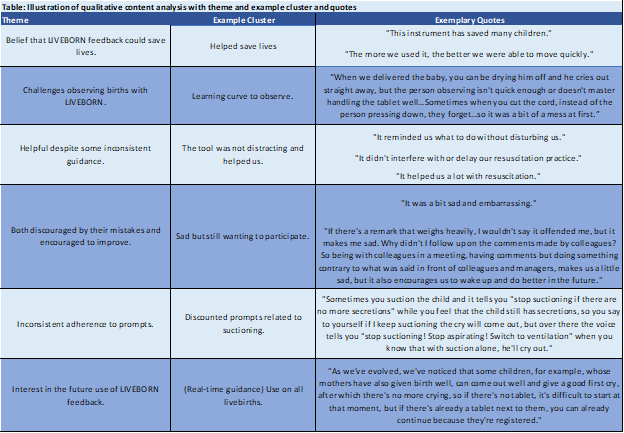Global Neonatal & Children's Health
Session: Global Neonatal & Children's Health 2
488 - Implementation of a Mobile Health Intervention for Feedback in Newborn Resuscitations: Perceptions and Experiences of Congolese Midwives
Friday, May 3, 2024
5:15 PM - 7:15 PM ET
Poster Number: 488
Publication Number: 488.69
Publication Number: 488.69

Amy Mackay, MD (she/her/hers)
Neonatal-Perinatal Fellow
University of North Carolina at Chapel Hill School of Medicine
Durham, North Carolina, United States
Presenting Author(s)
Background: Newborn resuscitation training reduces intrapartum-related deaths, but further reductions are limited by poor translation of training to bedside actions. Clinical feedback might enhance translation and can be accomplished using a mobile health application like LIVEBORN. LIVEBORN provides real-time guidance (RTG) and supports debriefing for newborn resuscitations (Figure). Midwives in the Democratic Republic of the Congo integrated LIVEBORN feedback into their clinical care for 8 months.
Objective: Explore the perceptions and experiences of Congolese midwives using LIVEBORN feedback.
Design/Methods: We conducted a 1.5-hour focus group discussion (FGD) at the two facilities with a convenience sample of 6 midwives per facility. One facility used debriefing, and one used RTG. We explored 1) initial impressions, 2) observing births with LIVEBORN, 3) incorporation of LIVEBORN feedback, 4) psychological safety, 5) changes in clinical care, 6) recommendations for optimization, and 7) future use. A trained moderator (DI) conducted FGDs in French, the local language, and later transcribed audio recordings. Using qualitative content analysis, AM coded French transcripts using Nvivo. Two reviewers (AM and JP) independently created English clusters of codes to identify patterns in the data, grouped clusters into themes, and determined final themes by consensus (Table).
Results: We identified three consistent themes from both facilities: (1) Belief that LIVEBORN feedback could save lives, (2) Challenges observing births with LIVEBORN, and (3) Interest in the future use of LIVEBORN feedback. Four themes emerged regarding debriefing: (1) Facilitation of debriefing by a head nurse midwife during morning meetings, (2) Both discouraged by their mistakes and encouraged to improve, (3) Correction of mistakes and increased self-confidence, and (4) Easy to understand LIVEBORN prompts but some prompts perceived as erroneous. Four themes emerged regarding RTG: (1) Helpful despite some inconsistent guidance, (2) Audio prompts did not feel like a reprimand, (3) Inconsistent adherence to prompts, and (4) Prompts were too quick.
Conclusion(s): Midwives believed that LIVEBORN feedback could help save newborn lives. The perception of erroneous and/or inconsistent guidance is a key barrier to effectively implementing automated feedback. We are investigating the effectiveness of LIVEBORN feedback in a pre-post cluster randomized controlled trial.
.jpg)

